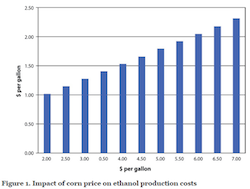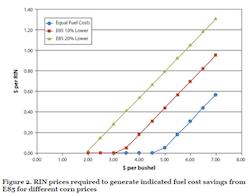According to a new analysis by the Center for Agricultural and Rural Development at Iowa State University, the so-called ethanol “blend wall” can be overcome and Renewable Fuel Standard (RFS) requirements can be met in 2014 and beyond through increased use of attractively-priced E85. The analysis is titled “Price It and They Will Buy: How E85 Can Break the Blend Wall.”
 “Pricing E85 low enough to generate fuel cost savings has the potential to quickly increase ethanol consumption, perhaps by three billion gallons over the next year or two,” write the study’s authors, Profs. Bruce Babcock and Sebastian Pouliot. “Rather than being a physical barrier to increased ethanol consumption, the E10 blend wall is an economic barrier that can be overcome by increasing the incentive for drivers to use E85 to fuel their vehicles.”
“Pricing E85 low enough to generate fuel cost savings has the potential to quickly increase ethanol consumption, perhaps by three billion gallons over the next year or two,” write the study’s authors, Profs. Bruce Babcock and Sebastian Pouliot. “Rather than being a physical barrier to increased ethanol consumption, the E10 blend wall is an economic barrier that can be overcome by increasing the incentive for drivers to use E85 to fuel their vehicles.”
The analysis demonstrates how the RIN market works to lower the effective cost of E85 at the retail level, and explains the interaction among corn, ethanol, gasoline and RIN prices.
“Current RIN (Renewable Identification Number) prices are high enough to achieve modest increases in ethanol consumption above 13 billion gallons and to create incentives to increase the ability to consume lower-carbon ethanol in 2016 and beyond,” the authors write. “Current high RIN prices create a large incentive for oil companies to increase consumption of E85 because expansion in E85 consumption will decrease RIN prices.”
The authors conclude that it will be less expensive for oil companies to invest in E85 infrastructure than it would be to continue to pay high RIN prices.
The authors also point out that the current fleet of flex fuel vehicles (FFVs) has the capacity to conservatively consume 6.6 billion gallons of ethanol annually and more FFVs are on the way. Further, they found that more than one-third of FFV owners have access to E85 within five miles from their home.Babcock and Pouliot are careful to point out that RINs will encourage increased ethanol consumption only if EPA resists pressure from the oil industry to dramatically reduce RFS requirements in 2014. The authors write that EPA’s final RFS requirements for 2014 and beyond must be “significantly above the E10 blend wall” in order for RINs to sufficiently drive E85 demand.
 Bob Dinneen, President and CEO of the Renewable Fuels Association (RFA), points out that this study underscores the fact that there are workable and economic pathways around the so-called E10 blend wall. “The CARD study exposes the absurdity of Big Oil’s contention that RFS requirements in 2014 and beyond can’t be met,” he said. “In addition to E15, increased E85 sales offer a clear and sensible pathway to compliance for obligated parties in the next several years. Bottomline, the RFS’ success — past, present, and future — lies in its inherent flexibility. It is time for Big Oil to comply rather than obstruct.”
Bob Dinneen, President and CEO of the Renewable Fuels Association (RFA), points out that this study underscores the fact that there are workable and economic pathways around the so-called E10 blend wall. “The CARD study exposes the absurdity of Big Oil’s contention that RFS requirements in 2014 and beyond can’t be met,” he said. “In addition to E15, increased E85 sales offer a clear and sensible pathway to compliance for obligated parties in the next several years. Bottomline, the RFS’ success — past, present, and future — lies in its inherent flexibility. It is time for Big Oil to comply rather than obstruct.”
“This analysis confirms what is already being observed in the marketplace,” continued Dinneen. “RINs are free when procured from an ethanol producer. It is not until that free RIN is detached from the gallon and begins being traded back and forth in an opaque, thinly-traded market that prices begin to rise. Ironically, though, higher RIN prices are translating into much lower E85 prices at the pump, and consumers are responding by buying more E85. In many locations today, a gallon of E85 is priced at least $1 less than regular E10. These dynamics explain why we recently saw E85 purchases in Minnesota double in just one month.”
Other recent third-party analyses, including a study conducted by private economist Philip Verleger for the Commodity Futures Trading Commission, have also concluded that E85 offers a workable solution to RFS compliance and the blend wall.

